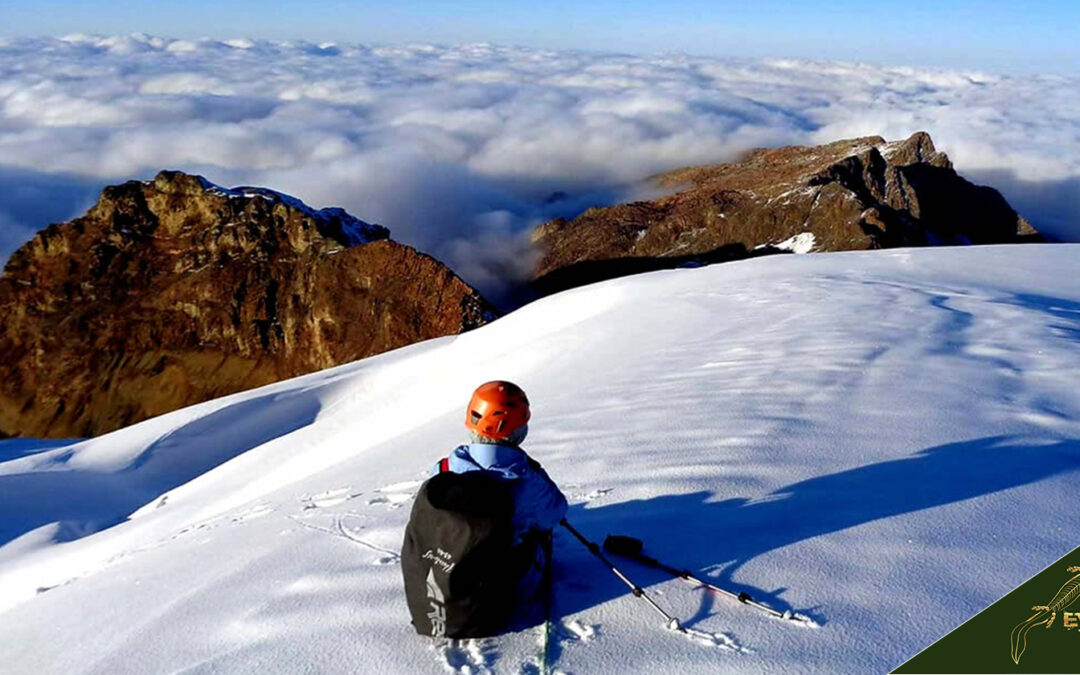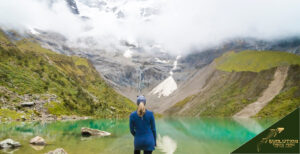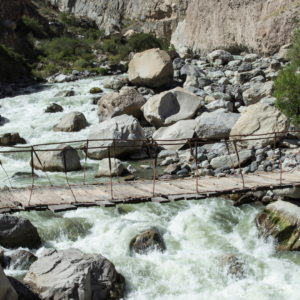Vallunaraju, also known as Wallunaraju, is a mountain nestled within the Cordillera Blanca, a section of the Andes mountain range, in Peru. The name “Vallunaraju” is thought to have roots in the Quechua language. It is believed that “walluy” refers to “cut” or “earless,” while “rahu” signifies “snow ” “ice,” or “mountain with snow.”
Situated in Huaraz Province, Ancash, Peru, Vallunaraju resides southwest of the neighboring peaks Ranrapalca and Ocshapalca.
The first documented ascent of Vallunaraju took place in 1949 when climbers A. And M. Szepessy successfully reached its summit. This achievement adds to the region’s mountaineering history, although it is essential to acknowledge that indigenous communities may have shared connections with the mountain spanning centuries or even millennia.
Rising 5,686 meters (18,655 feet) above sea level, Vallunaraju presents a challenge for mountaineers due to its high altitude. Experienced climbers are required to navigate its slopes and unpredictable weather conditions.
Various tour operators and mountaineering agencies offer expeditions for those climbing Vallunaraju. These guided tours cater to climbers seeking thrilling adventures and individuals who prefer guided ascents with training and equipment.
Vallunaraju forms a part of the Cordillera Blanca range, renowned for its captivating glaciers and lofty peaks at altitudes. Situated in the Andes, it stands as a feature within Peru’s landscape, attracting adventurers and mountaineers from all corners of the globe.
Like mountains in this region, Vallunaraju plays a crucial role in boosting Peru’s economy by drawing in tourists and adventure enthusiasts. The thriving mountaineering industry and tourism activities in the surrounding areas significantly contribute to businesses such as tour operators, hotels, restaurants, and transportation services.
The number of visitors heading to Vallunaraju varies annually based on weather conditions and global travel trends. Nonetheless, the mountain’s popularity among climbers and trekkers guarantees an influx of tourists to the area each year.
To sum up, Vallunaraju stands tall as an awe-inspiring mountain nestled within Perus Andes. With its challenging ascent and breathtaking landscapes, it holds significance not for the local economy but also for those seeking adventure and nature exploration.
What is the Vallunaraju History?
The majestic Vallunaraju, with its snow-covered peak, stands proudly in the Peruvian Andes. Located near Huaraz, this mountain got its name from the Quechua language combining “Valluna,” which means grandeur, and “Rahu,” representing a pinnacle.
The Inca people considered Vallunaraju land and believed it to be the dwelling place of Apu Callan, their deity associated with lightning, thunder, and storms. They would embark on pilgrimages to reach their summit.
During the invasion of Peru, Vallunaraju played a role in the resistance led by Inca leader Manco Inca. It served as a vantage point and a storage place for supplies.
Today adventurous climbers and thrill seekers often visit Vallunaraju. There are routes to conquer this mountain, but the path up the northern spur is particularly renowned. It involves a two to three-day journey through fields and icefalls until reaching the summit.
What does Vallunaraju Mean?
The appellation “Vallunaraju” derives from the indigenous Andean lingua franca Quechua. In that dialect, “Valluna” signifies pulchritudinous, and “Rahu” designates a niveous summit; ergo, Vallunaraju denotes “the comely niveous pinnacle”.
When did Vallunaraju get its name?
It was known that “Vallunaraju” was the title that the native dwellers of the mountainous area had utilized for ages. Given that the peak was viewed as a hallowed location and a destination for journeys by the Inca population before the Spanish subjugation of Peru, it seems probable that the designation harks back to pre-colonial periods.
Yet the precise moment Vallunaraju acquired its title remains obscured, for no manuscripts endure detailing the christening’s provenance. The designation presumably descended via the verbal conventions of those native to the region.
What are the theories about the origin of the Vallunaraju?
The ancient collision between two vast plates birthed the magnificent Cordillera Blanca eons past. Vallunaraju, nestled deep within, emerged in a forgotten age, its roots obscured yet fiercely debated. Some claim titanic forces rent the land asunder, upthrusting Vallunaraju’s flanks. Others posit a more gradual ascent, the summit rising imperceptibly over vast sweeps of time through the accumulation of layer upon layer. All that remains uncontested is the peak’s ageless beauty, a spectacle of rock and ice indifferent to human ponderings.
Vallunaraju, as hypothesized by certain researchers, arose owing to fiery plutonic forces, its lofty peak having formerly served as a conduit for molten rock and ash from the planet’s interior. Though now dormant, the mountain is thought to have once rumbled and spewed forth lava in a display of nature’s fury and creation.
The icy grind: An additional conjecture is that Vallunaraju came into being through the progression of frigid scraping away. The Cordillera Blanca chain possesses many frozen rivers, and it is feasible that Vallunaraju was formerly a much more massive peak worn down over the epochs by icy action.
The peaks of the land can be increased through the workings under the earth’s surface. The area of the Andes is recognized for the commotion beneath, and it’s likely Vallunaraju was slowly lifted over periods by these powers.
The sight of Vallunaraju evokes delight in all who gaze upon its grandeur, notwithstanding the uncertainty surrounding its precise beginnings. Irrespective of one’s native land or mother tongue, a soul-stirring appreciation for its picturesque peaks permeates all who chance upon its charming visage.
What are the myths about Vallunaraju?
The peak of Vallunaraju holds spiritual importance for the native inhabitants of the Andes, possessing a wealth of tales regarding its beginnings and meaning. To illustrate:
The tale of the deity Apu Callan: As per Inca legends, Vallunaraju was the abode of Apu Callan, the divinity of thunder, lightning, and storms. It was thought that Apu Callan governed the climate and that his existence on the peak safeguarded the neighboring settlements from catastrophes. The Inca would present oblations and carry out ceremonies to mollify Apu Callan and request his goodwill.
The narrative of the vulture and the hawk: In one myth of the peaks, the vulture and the hawk were vying to perceive who could soar the loftiest. The hawk ascended towering; however, the vulture, exploiting its brawny pinions, could sail up to the crest of Vallunaraju. The vulture then lowered to the inferior heights and avowed itself the conqueror of the contention.
The Chronicle of the Inca Opposition: Throughout the Spanish subjugation of the Inca Realm, Vallunaraju participated in the opposition campaign captained by the Inca chief Manco Inca. Rumor has it that Manco Inca and his adherents utilized the peak as an observation point to keep tabs on the Spanish and as a depot for arms and provisions.
The towering peak continues to represent an array of tales and fables for the native inhabitants of the range. For those whose lineage traces back to the slopes, the immense summit embodies a crucial emblem of their ancestry, chronicles, and devoutness.
Is Vallunaraju Important for Peru’s History?
The peak of Vallunaraju, akin to numerous elevated landforms spanning the South American mountain range, has played a pivotal part in the chronicles and civilization of Peru. The subsequent sentences delineate several rationales as to why Vallunaraju maintains such historical import for the country’s annals:
The once mighty kingdom worshipped the looming peak, believing the deity of loud roars and scorching flashes dwelled within. Pilgrimages were undertaken to beseech safekeeping and fortune. Tributes were presented to the towering natural wonder so its divine occupant might show favor.
An elevated bastion, Vallunaraju proved instrumental in the campaign of opposition orchestrated by the sovereign Manco Inca amid Spain’s 16th-century subjugation of Peru. Serving as a pivotal vantage point and depot for provisions, it facilitated the Inca’s endeavor to repel the conquistadors.
Mountaineering: The Vallunaraju currently draws in many peak scalers and thrill-seekers. It possesses a handful of paths of assorted challenge, with the most frequented being the standard course over the northern edge. The climb endures around a pair to the trio of sunups and entails adroit maneuvering on frost and chill.
Overall, the Vallunaraju is an emblem of the Peruvian cultural inheritance and natural legacy. For generations, it has formed the foundation of fables and folklore and endures as a favored haunt for those chasing escapades and mystic bonds with the Andean ranges.
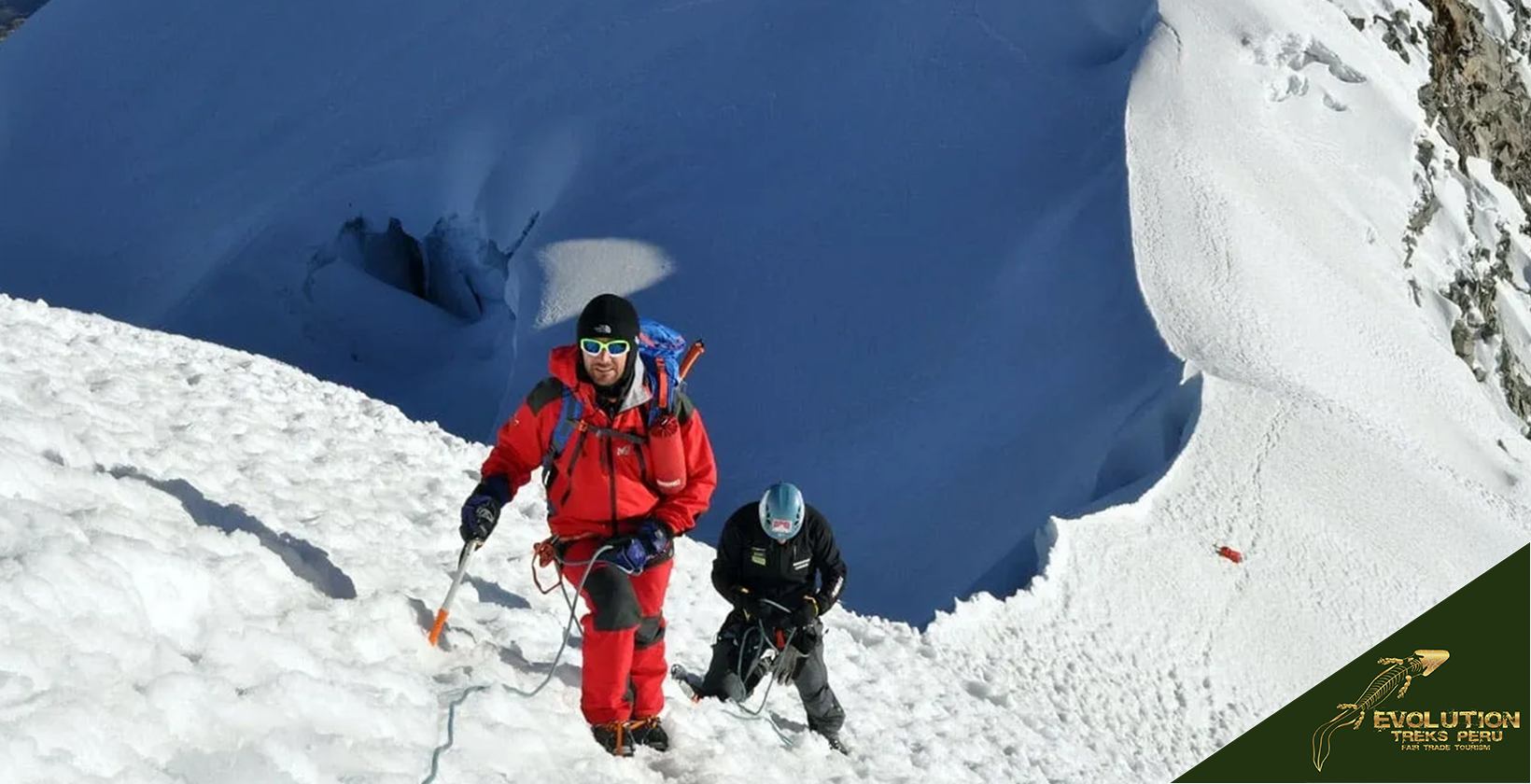
Where is Vallunaraju Located?
The majestic Vallunaraju stands in the lofty Peruvian Andes, adjacent to the settlement of Huaraz in Ancash. Towering over the tropics, the Cordillera Blanca’s snow-capped sentinels pierce the heavens, exceeding six thousand meters. Though lower, Vallunaraju’s 5,686 meter crest remains a coveted prize for those venturing into the thin air.
What are the coordinates of Vallunaraju?
The position of Vallunaraju can be approximated at 9.1398 degrees south of Earth’s equator and 77.5929 degrees west of the principal meridian.
How did Vallunaraju become well-known?
The peak earned renown chiefly for drawing thrill-seekers and explorers globally. The crag presents manifold taxing paths for mastering snow and frost, rendering it an in-demand terminus for veteran scalers chasing novel hurdles.
The peak’s positioning within the most elevated tropical mountain range of the Cordillera Blanca chain has augmented its prominence and fame. The territory is distinguished for its singular wildlife and breathtaking natural splendor, transforming into a sought-after venue for outdoor enthusiasts and nature devotees.
The mountain of old held great import to the peoples of the land, including those of the grand kingdom now fallen. The peak was hallowed ground for them, a place of power that fueled the spirit. Its stature has endured, an emblem of shared roots that still anchors a sense of self for those born to its base. Though empires may rise and crumble into dust, the connection felt to such a monument, passed from father to son, lives on.
The allure of Vallunaraju lies in its untarnished splendor, ancestral import, and arduous ascent paths, jointly effectuating its burgeoning fame and honor amid thrill-seekers and voyagers globally.
How is the Map of Vallunaraju Layout?
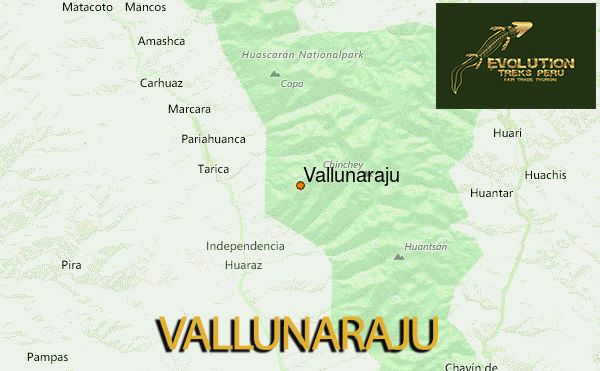
How is the Geography of Vallunaraju?
Craggy peaks, slippery ice sheets, and gravelly inclines define the landscape of Vallunaraju. The massive mound inhabits the White Mountain chain in the Peruvian Highlands, the loftiest Sierra in the hot belt, and is esteemed for its breathtaking pulchritude.
The icy peaks, Vallunaraju North and South, tower into the sky at uneven heights. Between the western Santa Gorge and eastern Llaca Ravine, the summits stand. At 5,686 meters, the loftier northern crest reigns. A mere 118 meters lower, its southern counterpart still climbs 5,568 meters upwards.
The peak is encircled by multiple sheets of ice that creep down its sides at a glacial pace, including the frosty Llaca to the upper reaches and the Shallap below. These slow yet steady rivers of chilled water serve as the lifeblood for those dwelling at the mountain’s base and provide a frigid home for diverse vegetation and wildlife.
The geography of Vallunaraju is typified by craggy mountain vistas and its unmatched spot inside the White Mountains chain. The peak is a vital element of the area’s natural legacy and is a favored goal for climbers and thrill-seekers globally.
What is the Geological Profile of Vallunaraju?
The majestic peak of Vallunaraju pierces the sky, its summit presiding over the landscape. The ancient stone consists primarily of granite, cooled and hardened in epochs past beneath the soil.
The stones comprising Vallunaraju are fragments of an expansive subterranean geological formation spanning countless leagues under the Andes. This immense bedrock assemblage coalesced amid the Jurassic and Cretaceous ages, approximating 200 to 65 million years antecedent, consequent to tectonic disruptions and magma infiltrations.
The icy slopes also provide housing for a handful of frozen rivers formed throughout countless winters due to built-up and packed snow. The frigid streams within Vallunaraju and other summits in the Ivory Range furnish critical hydration for neighboring inhabitants and enact an indispensable part in governing the locale’s weather and environment.
The geological nature of Vallunaraju and the neighboring White Mountain range shows the tangled tectonic and physical events over vast expanses of time, forming the Andes, and spawning breathtaking vistas.
What are the Hiking Routes near Vallunaraju?
Multiple walking paths and journeying selections near Vallunaraju proffer stunning vistas of the encircling peaks and scenery. A number of the favored mountaineering and travel routes in the region encompass:
The Santa Cruz trek meanders for four to five days through the picturesque Santa Cruz valley, glimpsing vistas of a few summits such as Taulliraju and Alpamayo.
The vista-filled journey courses through a trio of vales, spanning Llanganuco, Santa Cruz, and Ulta and proffering breathtaking panoramas of the pale peaks and a smattering of lofty lakes.
The passageway of Ishinca provides an abbreviated journey that guides you through the vale of Ishinca towards the foundation of Mount Ishinca. The trail is quite straightforward and presents vistas of various summits, encompassing Tocllaraju and Urus.
An Ascent of Vallunaraju: The peak presents a challenging scramble demanding adeptness and familiarity. The ascent consumes a pair to the triad of sunrises and incorporates scrambling over frost and ice.
The Alpamayo Circuit Trek provides an arduous journey encircling the renowned Alpamayo summit. Requiring between eight to ten sunrises to complete, the path unveils breathtaking vistas of numerous pinnacles in the Cordillera Blanca chain.
Overall, the paths for journeying and traversing in the vicinity of Vallunaraju provide an option for each individual, from brief and effortless rambles to arduous ascents and treks spanning numerous days.
How high is the Vallunaraju hike?
The lofty Vallunaraju, nestled in Peru’s White Mountains, possesses a duo of summits. Towering higher, the northernmost peak ascends to an altitude of over five thousand and six hundred meters. Slightly dwarfed yet still formidable, the southernmost summit reaches a height of five thousand five hundred and sixty-eight meters into the boundless Andean sky.
The immense peaks are typically quantified using the metric or imperial systems rather than the mile. For a sense of scale, the lofty 5,686-meter summit equals roughly 18,655 feet, a trio and a half miles high, give or take.
When is the best time to visit Vallunaraju?
The optimal occasion to traverse Vallunaraju depends on your intended activities and subjective inclinations. Certain factors merit contemplation:
The optimal period for ascending Vallunaraju is customarily amid the arid months, spanning May through September. Throughout this interval, the atmosphere is characteristically transparent and stationary, and the peak is broadly advantageous for the ascent. It is essential to note that even during the dry season, meteorological circumstances can change rapidly in high-height conditions, and climbers should constantly be set up for evolving conditions.
The mountaineering: Mountain climbing in the Cordillera Blanca chain can be undertaken anytime; however, the ideal period is usually amid the arid season, spanning May through September. During this duration, the atmospheric conditions are typically transparent and steady, and the routes are broadly in excellent condition. Nevertheless, it is crucial to observe that temperatures can plummet dramatically after dark, even during the arid season, and mountaineers ought to be equipped for frigid weather.
The optimum period to observe the fauna in the Cordillera Blanca region is typically throughout the rainy months, spanning December through March. As the flora flourishes and becomes verdant during this season, numerous types of animals are more lively and visible. Nevertheless, the rainy season can also usher in torrential downpours and dense fog, obscuring the vistas of the peaks.
The optimal period to explore Vallunaraju generally relies upon your intended activities and individual inclinations. Scrutinizing the atmospheric conditions and climate for the precise season of your intended visit and arranging for fluctuating circumstances in the lofty environs is crucial.
How is the climate of Vallunaraju?
The weather around Vallunaraju and the neighboring white mountain range is normally frigid and arid, with temperatures that can fluctuate broadly depending upon the season and height. The territory is situated in a high-height condition, implying that temperatures are commonly cooler than at lower rises.
The period devoid of rain spans from May until September in that locality. Throughout this interval, the day temperatures are customarily nippy, and nocturnal temperatures frigid, with averages fluctuating from about 10 to 15 degrees Celsius during the day to under the temperature at which water transitions between liquid and solid states at night. The conditions are typically transparent and arid during the dry season, with slim odds of falling moisture.
The period of precipitation spans the months between the tenth and fourth, while milder weather persists. Though mercurial skies often lead to rain or snow, typical daytime warmth is from ten to twenty degrees Celsius.
The climate near the towering Vallunaraju peak remains affected by its great height, with nippy to chilly air and crisp, transparent skies throughout the rainless months. As the wet period arrives, temperatures become more moderate, unsettling the weather.
Where to stay in Vallunaraju?
Several choices exist regarding lodging near Vallunaraju, from essential shelters to more luxurious retreats and inns. The following constitute a handful of possibilities worth deliberating:
The settlement of Huaraz, situated roughly sixty minutes of travel from Vallunaraju, acts as a favored hub for explorers of the White Mountain Range. The municipality provides an array of lodging selections, encompassing shelters, inns, and boarding houses to match any means and tastes.
Shelters and campgrounds dot the expanse of Huascaran National Park, the bastion of the famed Vallunaraju and sister sentinels of the Cordillera Blanca. These havens proffer an unvarnished and elemental sojourn amid vistas of the encircling summits and trails suited to rambling and scaling alike.
The valley of Llaca can be found east of the lofty Vallunaraju, proffering several fundamental encampments and shelters to wanderers and climbers alike. These lodgings tender a more secluded and crude living, with breathtaking vistas of the peak and straightforward paths to scaling courses.
Many hikers near the snowcapped Vallunaraju desire the fertile, deep valley of Santa Cruz. There are multiple essential places to stay the night and alpine shelters along the oft-walked trail. While simplistic and raw, they offer arresting scenes of the lofty summits and straightforward access to the climbing paths.
Overall, numerous lodging selections are proximate to Vallunaraju accommodating any pecuniary circumstances and partialities. Reserving beforehand is crucial, predominantly amid the zenith season, and scrutinizing the choices meticulously to ascertain the most suitable alternative conforming to one’s prerequisites.
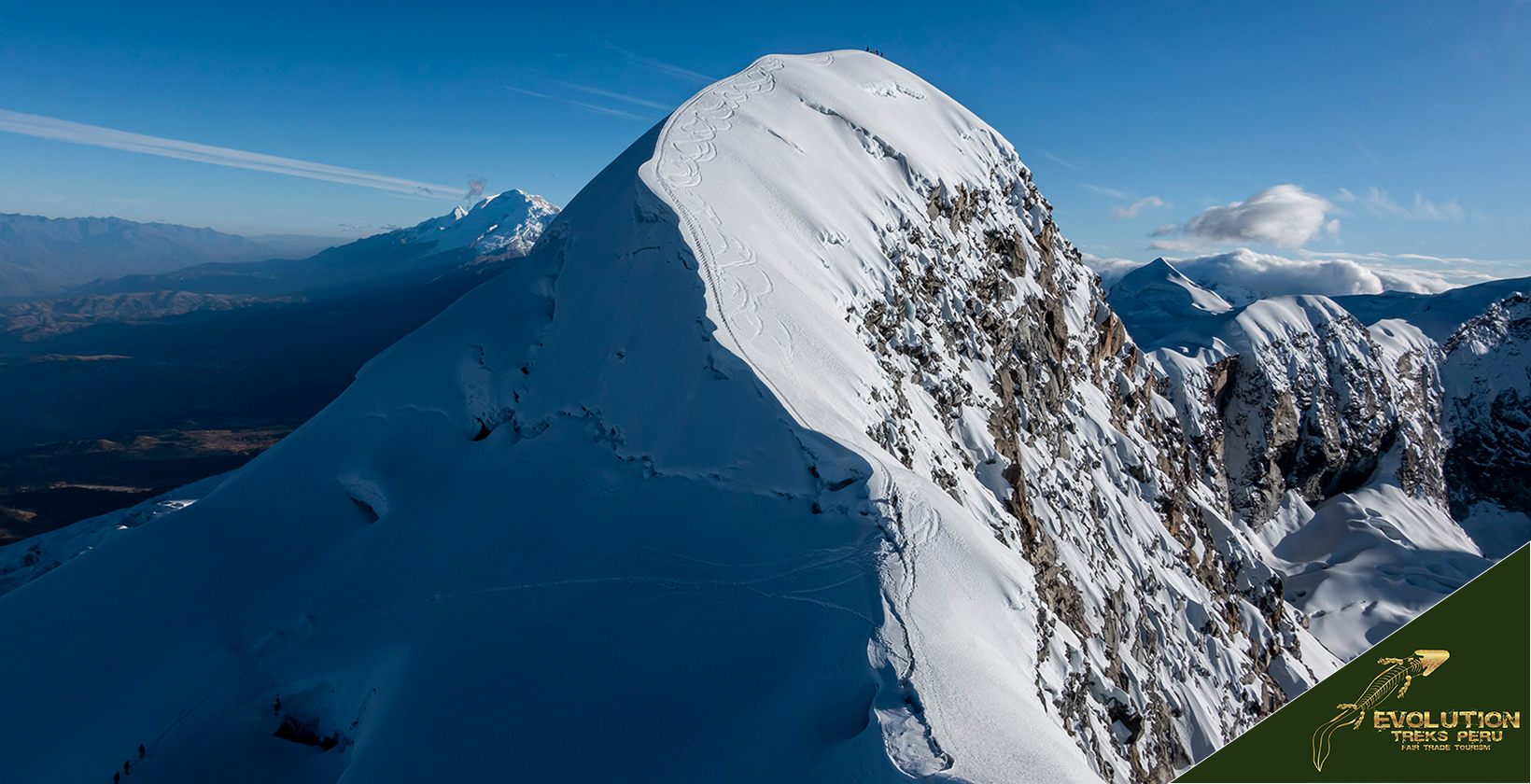
What are the Tours for Vallunaraju?
The mountainous region and its neighboring peaks provide an array of excursions and pursuits for travelers, encompassing rambling, trekking, alpinism, and ethnical outings. Presented are a few demonstrations of jaunts and deeds ready in the territory:
The ascent of Vallunaraju frequently appeals to veteran alpinists, who often enlist expeditionary enterprises facilitating supervised ascents of the peak. These ventures commonly mandate several sunrises and encompass acclimation treks and preparatory meetings.
The notoriously gorgeous trail winds through the valley of Santa Cruz, guiding explorers past many lofty mountain lakes and unveiling breathtaking vistas of the neighboring summits. Various expedition outfits provide chaperoned treks of assorted distances over this course.
The local inhabitants of Vallunaraju proffer tours that grant glimpses into the region’s cultural heritage. Excursions commonly encompass sojourns to hamlets in the vicinity, bazaars that have endured through generations, and locales of historical import. Visitors are afforded the prospect of becoming versed in the rituals, conventions, and folkways passed down through the ages. These cultural forays furnish a portal into the legacy of the autochthonous populations.
The peaks are abundant in the Cordillera Blanca mountain range, including the well-known Huascarán, Chopicalqui, and Alpamayo, attracting many mountaineers. Various travel organizations provide supervised ascents up these summits.
The peaks of the Cordillera Blanca cradle a motley crew of flora and fauna, counting llamas, alpacas, vicuñas, and condors amongst its inhabitants. Various expedition outfits provide supervised excursions centered on watching and capturing images of the native wildlife.
Many explorations and pursuits are on offer in the vicinity encompassing Vallunaraju. Holidaymakers can select from an assortment tailored to their penchants and adeptness. It remains imperative to elect a prestigious journey corporation and arrange in advance to certify the excellent feasible encounter throughout your vacation.
What are the Closest Destinations to Vallunaraju?
Near the Peruvian city of Huaraz rests Vallunaraju amidst the Cordillera Blanca mountain range of the Andes. Though solitary, the locale is neighbored by distinct places exhibiting individual allurements.
In the Cordillera Blanca’s premiere protected area, Huascarán shelters striking vistas unparalleled in grandeur throughout the land. Snow-capped sentinels pierce azure firmaments while teal tarns reflect cerulean skies. The park attracts droves yearning to tread trodden trails and scale slopes where condors soar. Fauna flourishes in forests fringing the frosty massif, a photographer’s paradise and trekker’s treasured terrain.
Huaraz, a bustling municipality, is the most populous civic area in the vicinity and acts as a nexus for recreation and daring undertakings amid nature. Renowned for its spirited customs, antiquated constructions, and energetic bazaars, this settlement furnishes an extensive assortment of lodging and victuals selections.
The pre-Inca sanctuary, Chavín de Huantar, positioned in the proximity of Chavín, constitutes one of Peru’s most noteworthy remnants from before the appearance of Europeans. Comprising striking rock structures, ornate etchings, and underground passageways, it proffers an enthralling peek into the antiquated civilization inhabiting the Andes.
Hidden amid the Cordillera Blanca peaks, a vibrant teal lake awaits discovery. Parón, a glacial wonder, fills a valley near the community of Caraz. Its waters, renowned for their striking color, reflect the grandeur of the snow-capped sentinels encircling the lake. A mecca for those seeking adventure in the Andes, the unspoiled surroundings attract the intrepid explorer. Whether hiking the trails, angling for trout, or simply soaking in the serenity of the setting, Parón rewards the traveler venturing into its realm.
The vicinity enveloping Vallunaraju proffers copious innate and civilized allurements for voyagers to probe, rendering it a favored terminus for wanderers questing escapades and examinations in the Andes.
How to Get from Lima to Vallunaraju?
The lofty Vallunaraju inhabits the pale peaks of the Peruvian cordilleras adjoining the Huaraz hamlet in the Ancash province. The sprawling capital of Lima resides four hundred kilometers southward. Several paths wend from Lima to Vallunaraju:
The primary mode of transport between Lima and Huaraz, adjacent to Vallunaraju, is motor coach. Several companies operate buses connecting Lima and Huaraz daily, and the ride endures around 8 to 9 hours. After arriving in Huaraz, sightseers can hail a cab or employ an escort to traverse Vallunaraju.
Domestic carriers convey guests between Lima’s bustling metropolis and Huaraz’s scenic mountain town in roughly 60 minutes. These aerial transports can prove rather pricey and may be inaccessible on certain dates, fluctuating by season.
Custom voyages: Adventurers can also organize a bespoke voyage from Lima to Huaraz, which could be cozier and more fitting than embarking the coach. Numerous escapade organizers and conveyance corporations offer made-to-order voyages, with costs fluctuating depending on the extent of the gathering and the degree of solace wanted.
In summary, the optimal way to traverse Lima to Vallunaraju hinges upon your inclinations and means. Embarking upon the omnibus constitutes the most prevalent and reasonably priced selection. In contrast, a secluded conveyance or aerial voyage may prove more commodious for those disposed to disburse an amplified quantity.
What to know before going to Vallunaraju?
Despite preceding pilgrimages to Vallunaraju, various vital variables verify prudence and pleasure. Several salient subjects sustain sagacity. Prior peregrinations portend peril. Provisions preclude privation. The trodden trails tend treachery. Though the terra’s beauty beckons, beware the beast. The genteel guidebooks gloss over the gorge’s grievous dangers. Grim tales tell of gallant travelers, now ghostly tenants. While wonders woo wanderers, the wayward way leads to eternity.
The lofty Vallunaraju has twin peaks that reach the sky; the taller zenith attains an airy 18,655 feet while its shorter sister summits at a breathless 18,267 feet. Venturers should ready themselves for the consequences of such rarefied elevations, including difficulty respiring, exhaustion, and cranial throbbing. It is imperative to gradually habituate to the thin air and imbibe copious liquid to remain hydrated.
The climatic conditions of the Andes are erratic, and explorers must equip themselves for abrupt variances in degree, breeze, and rainfall. Packing suitable attire and apparatus for the lofty terrain is imperative, encompassing insulated garments, waterproof outerwear, and rugged trekking shoes.
An arduous ascent, Vallunaraju necessitates alpinists to possess a robust constitution to surmount its apex. Imperative mountaineers adequately prepare and boast exploits at lofty elevations with climbing peaks.
Gear mandated to ascend Vallunaraju should be procured, encompassing ascension ropes, ice cleats, mountaineering hatchets, and additional safeguarding accouterments. It is imperative to certify all apparatus is acceptable and inspect provincial ordinations appertaining to ascending and safeguarding outfits.
Native groups inhabit the mountainous area, so sightseers should appreciate regional practices and conventions. Comprehending domestic civilization and contemplating travel’s sway on the neighborhood surroundings and trade is essential.
Those venturing into the area should bear certain considerations to embark on a secure and pleasant excursion within Vallunaraju and the nearby peaks of the Cordillera Blanca.
How is the Vallunaraju Itinerary?
The Vallunaraju climbing tour in the Cordillera Blanca usually spans two days offering an opportunity to reach the summit. Here’s a detailed outline of the itinerary;
Day 1;
Starting from Huaraz, The tour commences, in the city of Huaraz, where participants gather and prepare for the adventure.
Heading to Llaca Valley, The group embarks on a 1.5-hour drive to reach the Llaca Valley, which serves as the starting point for the climb.
Trekking to Moraine Camp; From Llaca Valley, we embark on a hike. Climbers ascend a ridge for about 2 to 3 hours until they reach Moraine Camp at 4,760 meters.
Breathtaking Scenery; Along this trek, participants are treated to awe-inspiring views of peaks such as San Juan, Ranrapalca, Ocshapalca, and Leon Dormido.
Overnight Stay at Moraine Camp; Once we arrive there, climbers settle in for the night. This allows them to rest and acclimatize to the altitude before pushing towards the summit on the day.
Day 2;
Early Morning Start; The second day kicks off in the morning around 4;00 am. This ensures time for ascending and descending safely, for the Glacier and Snow/Ice Climb climbers gear up in their mountaineering equipment. Begin their journey towards the summit through a snow and ice climb. The southwest face is usually the route for this ascent.
The climb to reach the summit of Vallunaraju, which stands tall at 5,685 meters ( 18,655 feet) takes around 4 hours. During this time, climbers are guided by professionals who offer support and guidance during the exposed section of the last 60 meters.
At the summit, participants are treated to breathtaking views of the Andean landscape. After taking in these awe-inspiring sights, climbers descend back to Moraine Camp, which typically takes 2 hours.
The group retraces their steps from Moraine Camp to conclude this two-day climbing tour. Returns to the Llaca Valley. From there, participants drive back to Huaraz.
It’s important to highlight that climbing Vallunaraju requires fitness, strength, and prior acclimatization to high altitudes. Please note that due to weather conditions and the overall pace of the group, during ascent, slight changes may occur in the itinerary.
How much does it cost to visit Vallunaraju?
Climbing Vallunaraju in Peru is an adventure suitable for beginners and experienced mountaineers. The cost of the expedition can vary depending on factors such as the duration of your trip, the level of service you prefer, and the time of year you choose to visit.
On average, a two-day journey to conquer Vallunaraju can range between $415 to $1,500. Let’s break down these expenses;
Accommodation; While staying in Huaraz, you have options like a bunk bed in a hostel for around $50 per night or a private room for $100 per night.
Food; If you’d like to cook your meals, budget around $20 daily for groceries. If dining out is more your style, expect to spend $30 per day on food.
Guide; A qualified and experienced guide is essential for climbing Vallunaraju. The cost of having a guide accompany you on this two-day trip is $300.
Porters; To help carry equipment during the expedition, hiring porters is necessary. You can expect to pay $100 for their services throughout the two days.
Transportation; Getting to and from Vallunaraju can be quite expensive due to flights into Huaraz followed by taking a bus to reach the trailhead.
The estimated cost for round-trip transportation is $300.
When preparing for a climb, it’s crucial to have mountaineering gear. You should budget around $500 for equipment like a sleeping bag, tent, crampons, ice axes, helmet, harness, and other necessary items.
Vallunaraju offers climbing opportunities throughout the year. The best time to climb is from April to October, when the weather tends to be sunny and warm. However, it’s important to acclimate to the altitude before attempting the ascent since Vallunaraju reaches heights over 5,000 meters.
The tour cost includes transportation per the itinerary, a guide, and porter services for group equipment carrying all meals during the climbing adventure. Quality high mountain tents, ropes, cooking utensils, a first aid kit, and oxygen are also provided.
The tour price does not cover your breakfast and last dinner expenses or personal equipment costs. It also excludes water and alcoholic drinks charges. Entrance fees to Huascaran National Park are not included either. Furthermore, you should note that this package does not include medical care expenses, emergency rescue or evacuation costs, travel insurance, payment for hotel accommodation, flights, and optional tips for guides and crew.
Before you start the climb, it’s important to ensure that you are in shape, accustomed to the altitude, and have the right gear. Moreover, you can reach Vallunaraju Basecamp by minivans or comfortable 4×4 off-road vehicles, and porters will help carry the equipment while you handle your belongings.
By getting ready for the climb, adventurers can have a fulfilling time on the breathtaking slopes of Vallunaraju.
How many hours should a person spend in Vallunaraju?
The duration of one’s stay within Vallunaraju would depend on the specific itinerary and pursuits of the individual. A few options include:
An alternative excursion: Should your schedule be constrained or an overnight stay in the elevated terrain be undesirable, a single-day journey to Vallunaraju can prove a splendid choice. This commonly encompasses a there-and-back trek from the mountain’s foundation to one of the nearby summits or vistas, potentially requiring 6 to 10 hours contingent on the path selected and your vigor.
An extended adventure in the heights: Instead of a quick visit, you can remain for a day or two at one of the lofty campsites near Vallunaraju. This provides the opportunity to become deeply acquainted with the region and, if you are a practiced climber, attempt overcoming one of the summits.
A lengthy hike: Should your schedule permit and the desire to traverse further into the Cordillera Blanca peaks entices, undertaking a trek of numerous sunrises and sunsets, including Vallunaraju, as but one scenic portion proves feasible. The pathways of Santa Cruz and Huayhuash Circuit stand as a pair of frequented choices, commonly consuming between four risings and ten sun settings to finish, contingent on the trodden road and your swiftness.
“On balance, the duration an individual allocates in Vallunaraju depends on their itinerary and pursuits. Irrespective of craving a fleeting excursion, protracted mountaineering, or trekking exploit, selections are accessible to gratify your necessities.”
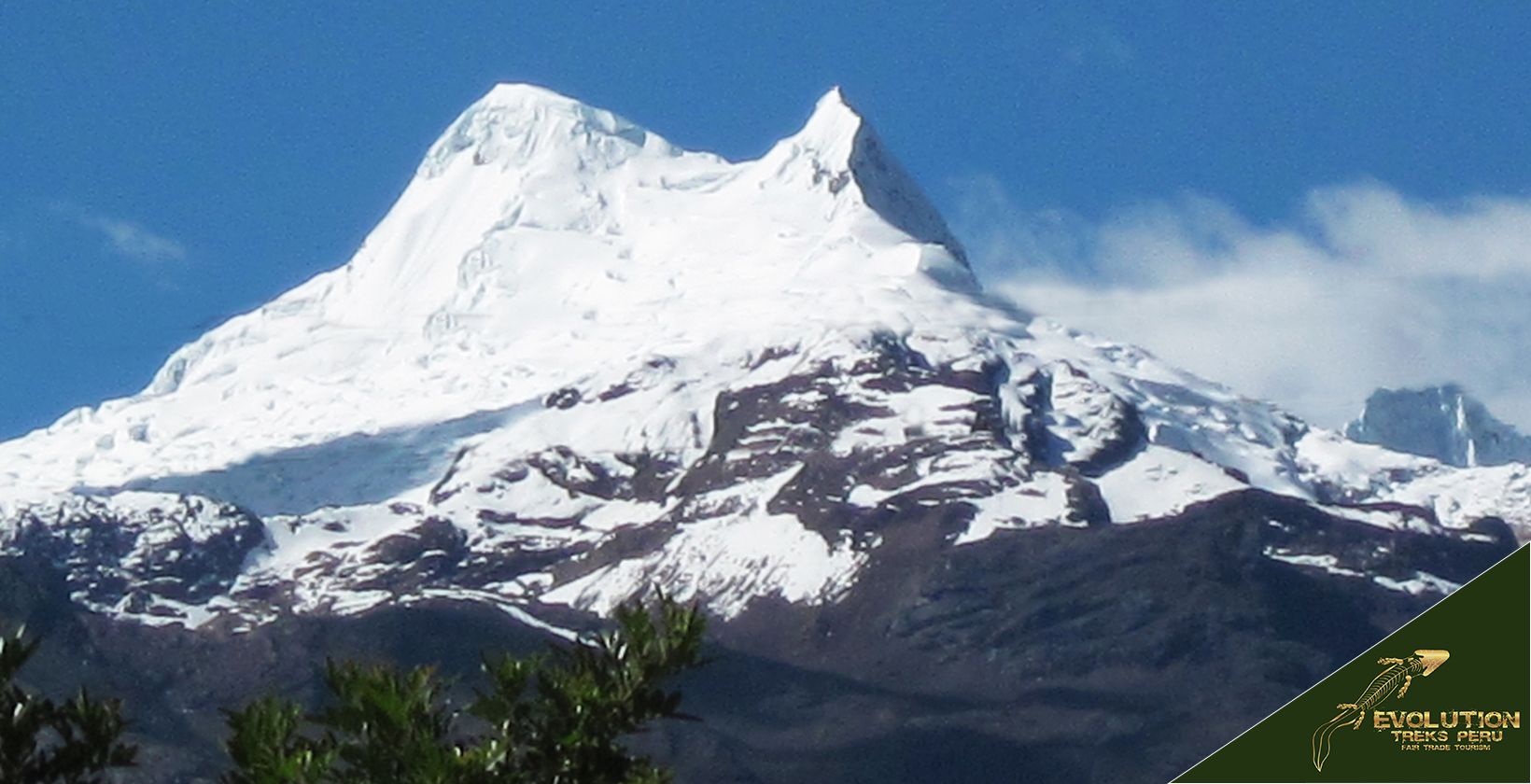
What is the nearest city to Vallunaraju?
The closest metropolitan locale to Vallunaraju would be Huaraz, roughly 12 kilometers southeast of the peak. As the most substantial populace inside the Cordillera Blanca district of the Peruvian Andes, Huaraz is a prevalent center point for guests investigating the area. It gives various lodging choices, eateries, and visit administrators, just as access to nearby attractions like Huascarán National Park and the Llanganuco Lakes. Huaraz can be effortlessly come to by transport, taxi, or private vehicle from Lima or other nearby urban communities.
How is the Preservation of Vallunaraju?
Protecting Vallunaraju and the neighboring White Mountain Range remains essential, considering the region’s distinct environmental and social importance. The following are some undertakings in progress to maintain and defend the vicinity:
The mountainous region shelters governmentally supervised refuges, including the Huascarán refuge and the Huayhuash segregated locality. The Peruvian administration operates these asylums subject to rules and defenses to safeguard the territory’s natural surroundings and ancestral legacy.
The advocates champion environmentally-conscious and community-centric hospitality. Various area-specific travel bureaus and collectives endorse supportable recreation by lessening visitor impression of surroundings and bolstering inhabitants. This comprises responsible refuse regulation, nature-obliging lodgings, and neighborhood-anchored travel initiatives.
Preservation of customs and artifacts: Actions are ongoing to conserve the historical legacy of the locality, encompassing native rituals and excavation locations. This comprises initiatives to chronicle and advance time-honored conducts and tongues, plus drives to safeguard and renovate notable places and relics.
Variance in atmospheric temperatures poses a significant hazard to the Cordillera Blanca mountain range and nearby vicinities, as increasing warmth results in liquefying ice sheets, fluctuating natural environments, and other consequences. Attempts are in progress to alleviate the effects of atmospheric variance in the locality, encompassing diminishing greenhouse gas discharges, advancing renewable power, and employing adaption tactics.
Safeguarding Vallunaraju and the peaks of the Blanca Cordillera presents an intricate and unremitting undertaking necessitating the exertions of diverse interested parties, encompassing official bodies, indigenous populations, and travel consortiums. Through combined endeavors to shelter and maintain this domain, we can guarantee descendants the delight and wealth of culture singular to this picturesque expanse.
Is Vallunaraju in UNESCO World Heritage Sites?
The peak is excluded from the catalog of landmarks endorsed by the international organization. Though adjacent is a national park incorporated into a biosphere under the guard of that same global body. In 1985, the reserve was designated as a place of notable scenic beauty and biological variety, encompassing species found nowhere else and a spectrum of environments from lofty summits to dense woodland. The park and its surrounds are likewise meaningful for their anthropological heritage, inhabited by certain native groups and retaining singular conventions and usages. While the mountain is not officially on the roster of sanctified sites, it forms part of a broader stretch of peaks seen as a natural and cultural treasure of the nation and the continent.
Is Vallunaraju in danger?
Unparalleled and picturesque, the natural and cultural sites near Vallunaraju confront various difficulties of an ecological and communal nature which place their continued existence in peril. Enumerated hereunder are certain dangers to Vallunaraju itself:
The surroundings of the Cordillera Blanca realm, including Vallunaraju, are peculiarly receptive to the consequences of shifts in weather, encompassing melting masses of ice, transformations in rainfall models, and the magnified likelihood of catastrophes spawned by nature.
The locality’s renown as a destination of interest for wanderers has burdened innate and cultural means, encompassing paths for rambling, sites to pitch tents, and places of antiquity.
Exploration of natural resources can prove detrimental to the environment. Projects extracting minerals and fuels threaten the purity of water and air and damage local habitats. While the zone houses multiple mining operations, their effects on the surroundings raise awareness. Similarly, prospecting for oil and natural gas in the vicinity worries conservationists about the consequences to come.
Parcels of soil meet new purposes: As forests disappear, crop fields blossom and cities swell, the spaces where plants and animals dwell and artifacts of bygone eras can suffer harm.
Strides are happening to confront these obstacles and safeguard the innate and historical legacy of the Cordillera Blanca locale, encompassing Vallunaraju. Those strides comprise protection drives, maintainable tourism customs, and civic participation to guarantee that neighboring populaces are embroiled in choice-making courses. Despite a few looming perils to the zone, numerous constructive drives are in progress to secure its conservation for prospective generations.
Can you get altitude sickness while trekking Vallunaraju?
A trek to the peak of Vallunaraju or neighboring Cordillera Blanca summits can induce altitude sickness. This frequent disorder, also known as acute mountain sickness, usually arises at elevations surpassing 2,500 meters. Manifestations encompass migraines, nausea, lightheadedness, lethargy, and disrupted slumber.
To diminish the likelihood of disorders related to substantial elevations, appropriate adjustment to such an environment and cautionary measures during hill walking in lofty regions are imperative. The subsequent points can aid in decreasing the chance of ailments sprung from altitude:
Slowly gaining altitude: One should increase in height leisurely, permitting your physique to adapt to the elevation. Refrain from ascending above around 500 to 600 meters, roughly 1600 to 2000 feet, in a single day, and take days of rest when necessary.
Quench your thirst: Consume adequate amounts of the liquid elixir to circumvent desiccation, which intensifies the manifestations of the malaise induced by lofty elevations.
Shun alcohol consumption and the lighting of cigarettes: The imbibing of spirits and ignition of tobacco sticks exacerbates the manifestations of elevation infirmity; thus, it is optimal to eschew these substances while mountaineering.
Obtain provisions: Certain wanderers can gain from acquiring provisions to avert or remedy elevation infirmity. Confer with a health practitioner previous to ingesting any provisions.
Recognize indications of elevation affliction: Note the indications of elevation affliction and pursue medical consideration if manifestations intensify or don’t improve with relief.
On the whole, though the affliction of elevation nausea poses a conceivable threat when traversing Vallunaraju or other lofty territory, it is achievable to decrease the peril with fitting adaptation and safeguards.
Is camping allowed in Vallunaraju?
Camping can be done in the region of Vallunaraju, however, there are a few limitations and suggestions that sightseers ought to consider. The following are a couple of things to remember:
Camping grounds: Multiple specified locations in the region of Vallunaraju are available for visitors to utilize for overnight stays. These locations are customarily situated at decreased altitudes and provide essential amenities such as lavatories and water provisions.
One must procure authorization from the administrative center of Huascarán National Park in Huaraz to bivouac in the vicinity of Vallunaraju. The tariff for this sanction subsidizes preservation endeavors in the reserve and guarantees that sightseers adhere to the mandates and stipulations of the park.
Journey considerately: It is vital to uphold the practice of leaving nothing behind when spending nights in the Vallunaraju region. This entails removing all litter, utilizing recognized encampments, shunning harm to plant life, and avoiding open flames.
The fauna of Vallunaraju is abundant, encompassing condors of the Andes, vicuñas, and pumas. Adventurers must revere the creatures therein and abstain from nourishing or nearing them.
Weather: The atmospheric conditions surrounding the locale of Vallunaraju are volatile and intense, with powerful gusts, torrential downpours, and electrical storms prevalent at greater heights. Explorers must equip themselves for meteorological events and possess suitable attire and apparatus.
Broadly speaking, pitching tents in the Vallunaraju region is permitted, however, sightseers ought to heed the instructions and rules to guarantee a secure and pleasant experience while diminishing their impression of the area.

Miguel is a professional tour guide from Cusco, Peru, with almost 20 years of experience leading tours and a deep knowledge of Peru’s cultural and ecological diversity. He is also an advocate of ecotourism and cultural sensitivity and has lectured on these topics in the US and Europe. He co-founded Evolution Treks Peru, a worker-owned travel company based in Cusco.

